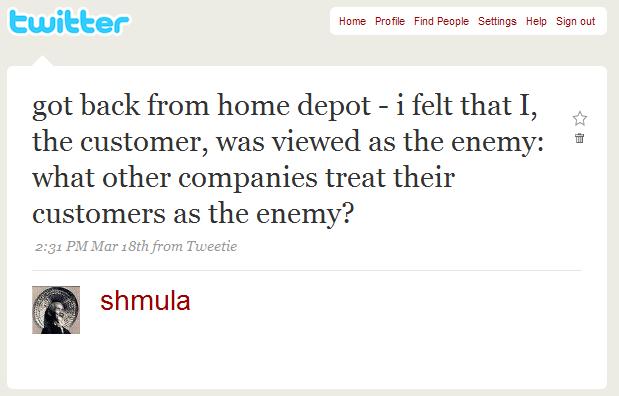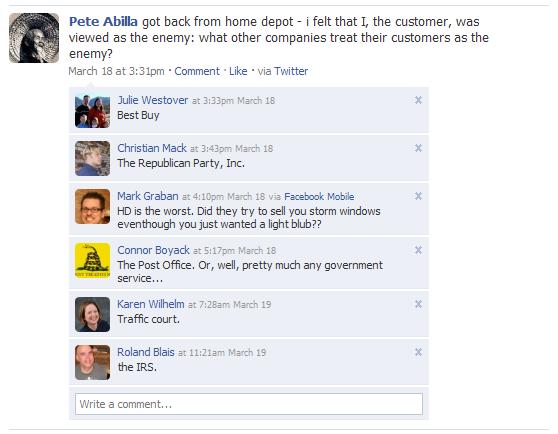Customer Service Retention Example – A Chance for Redemption is an article about my experience at Home Depot – what they did to respond to my dissatisfaction and what they did in an attempt to win back my loyalty.
In a very tough economy, keeping customers happy should have more considerable weight and attention from companies. I had a negative customer experience recently at Home Depot, where they had a chance to redeem themselves from a very poor customer experience.
On March 18, 2009, I went to Home Depot to buy some tools to help my son with his Boy Scout Pinewood Derby car. I’m completely unskilled when it comes to tools or wood carving, so I needed help. I asked someone at Home Depot to help, but the person I asked was very irritated at me and sent me to another department. At that department, the associate said: “sorry, can’t help you.” It turns out, I just needed sand paper and a hand saw, which my neighbor let me borrow.
Following that experience, I sent this Tweet:

I have 296 people following me on Twitter and all my Twitter updates also updates my Facebook page, where I have 350 friends. So, ~600 people saw that Tweet. Six people responded to that Tweet on my Facebook page:

So, negative word-of-mouth from 1 negative experience quickly reached ~600 people. We know from Net Promoter Score (NPS) studies that a Detractor is quite costly to a company, with some studies showing that a Detractor carries a Net Cost of at least $300 USD, not to mention the 600 people that my negative word-of-mouth reached. The same study shows that a Promoter carries a Net Benefit of $1,700 USD.
Moreover, this blog has 1359 Feed Subscribers and an average daily visitor count of 930 unique visitors. So, 1359+296+350+930 = 2935 people are quickly reached from one negative word-of-mouth experience.
So, 1359+296+350+930 = 2935 people are quickly reached from one negative word-of-mouth experience.
In this economy — no, in any economy — a firm cannot risk having negative word-of-mouth or risk producing a bad customer experience: not good for the customer; not good for company.
A Chance for Redemption
My original tweet above, however, caught the attention of Home Depot, to which they responded with the Tweet below:

My initial reaction was very positive — wow, Home Depot monitors Twitter and responds quickly to negative word-of-mouth in the Twitter stream.
I sent @HomeDepot a direct message, containing my email address; I didn’t receive a response for a while, then I received the Tweet below:

The Tweet was followed-up with an email, which is below:
Pete I’m very sorry to hear that you were treated so poorly. Which store did you visit? I take your experience very seriously and would like to pass your comments along to our store and local leadership.
We are making improvements across the board, but it takes feedback from customers like you to make direct changes in specific stores, send additional resources, etc¦
Also, I’ve alerted our Customer Care team, who may contact you as well to resolve this matter and thank you properly for taking the time to give us this feedback.
Please let me know where this happened, and if it’s a normal occurrence at that location, or something unique to this visit.
XXX XXX, Corporate Communications Manager
The Home Depot
I responded to @homedepot’s email with my detailed experience on March 20, 2009. Since then, no feedback or response.
Lessons Learned
- Most customers are charitable and give companies the benefit of the doubt; most customers are willing to give several chances to a company. I’m certainly in this camp.
- This means that, from the firm’s perspective, there is ample chance to win-back customers through simple empathy, listening, and reaching-out, not necessarily by giving of anything monetary.
- If you are going to have an outreach effort like Home Depot above, execution is key. This means that the initial outreach must reach a conclusion. This is where Home Depot fails. They made a good effort, but no conclusion was reached. I’m happy they reached-out to me, but no feedback was given regarding the negative experience I shared with them.
- Monitor Twitter, Facebook, and other social media. Negative word-of-mouth can quickly diffuse to millions of users. My single negative word-of-mouth tweet quickly reached ~600 people. Most likely, some of those ~600 people will not purchase or recommend Home Depot, because of my negative word-of-mouth experience.
Insult to Injury
One more word of advice: a customer’s 1st negative experience can be considered “injury”. Customer Service can take on a balming effect or it can add “insult” to the initial “injury”. Keep this in mind as you frame your Customer Experience strategy.
Hippocratic Oath for Customer Experience
“Do No Harm” ought to be our mantra; “Do No Further Harm” is a great one to have as well.








This is an excellent post regarding your experience with Home Depot. You do an exceptional job of demonstrating how comments like this on your experience spread quickly. I also liked how you cite the monetary value of both positive and negative comments.
I am particularly impressed that Home Depot was monitoring and picked up the Twitter comments and then just as disappointed that they failed to follow up. While their original email does state that their Customer Care may contact you, as you point out, they missed an opportunity for redemption. By asking for the additional information (as they did), there is an implied expectation that feedback will be acknowledged in some form or fashion.
I always think that posts involving examples that everyone will recognize help serve to make the point. In fact, my next post that is already written and scheduled for later this week also uses a major retailer as an example of the lean over processing waste.
I recently blogged about my terrible retail experience buying a replacement refrigerator lamp. The failure was stupendous. See link.
I made it clear to company management that my experience was a wasted opportunity for profit because they wasted my time. In doing so I tried to give them advice on how they could serve me and people like me better. I hope it helps.
I really appreciate the link to the NPS studies.
Great analysis of your experience and its far reaching impact.
I agree with your “Hippocratic Oath for Customer Experience.” If a company is going to start the conversation with disgruntled customers, they need to finish it. Otherwise the already damaged relationship can go into a death spiral.
@NetPromoter
@shmula that is a brilliant example of poorly managed close-the-loop process. Thanks for sharing it!
Pete
This is Sarah from The Home Depot. I received your email and your feedback has been shared with the store and folks here who are able to take feedback from customers and put it to use to improve customer service in our stores.
We absolutely do not want you to continue to experience this type of service from us, and detailed feedback like you provided after we took our conversation off twitter goes a long way to help us make the necessary changes at the store level.
Sorry I did not respond more quickly to your email, but I want to assure you that your feedback has been shared internally, both with the store you visited and folks on our customer service team who are in a better position than I to resolve this matter with you.
I am sorry we let you down, both in the store and in my lack of follow up after we exchanged emails Friday.
Sarah, Home Depot Communications
information(at)homedepot(dot)com
This is simply brilliant. I read it twice , very profound!
Thanks for sharing
It’s unbelievable that companies aren’t staffing for this type of thing. The math you used to calculate the number of people that received your feedback should be one of THE TOP METRICS that companies use for Social Media efforts. Any thoughts on how we could apply Six Sigma to get better metrics and control over customer feedback processes like this?
Bloggers know the space really well and your post, as well as ones like this from Allstate http://www.handshake20.com/2009/03/modea-twitter.html, goes to show the POWER that companies can have by using this properly.
Right now, companies do this as a source of competitive advantage…but soon, it will be a competitive necessity.
Pete, your story about Home Depot rings very true, I am a frequent shopper of both HD as well as Lowe’s and the customer service experience at both of these locations in my hometown of Parkersburg, WV are almost always below-par. The one constant that I almost always walk away from at the stores is feeling that any questions I may ask are viewed as bothersome, perhaps the most troublesome aspect of this is the complete contrary message both of these retail ginats use in their marketing and ad campaigns although maybe their recent change indicates they have given up on being a customer-centric organization going from “You can do it, we can help” to now being “More saving, more doing” (which to me, the latter is the epitome of an “empty” slogan. I am proud to work for an organization that puts the customer first, not just in ads/marketing, not just in the board room or internal meetings, but real accountability to do it on the front lines. I enjoy getting feedback that my branch provides service that is unparalleled, but at the same time, I’m puzzled as to why it’s unparalleled.
Pete, reading your story reminds me of a funny “failed redemption story” I experienced with Alice DSL, a HanseNet/Telecom Italia company:
Before I moved to my current flat I had a DSL internet connection with Alice I wanted to keep. So I checked out the new location on the Alice website and got green light “DSL available at this location”.
I moved and got my new phone line with DSL. The phone worked but not DSL. After 2 visits of the Alice technician I was told that the signal strentgh was too weak – no way to get DSL. So I quit the DSL contract but stayed with the phone contract which costs me 20 bucks for the contract change. For internet connection I used an expensive UMTS cell phone access, spending ~750 USD over the DSL rate since then.
Then by chance I talked to my neighbour living in the same house, telling me from his fast Alice DSL connection … The technician had told me nonsense.
I called Alice customer support and asked to try again to switch on my DSL but they asked for another 20 bucks for the new contract change – as well as the mail support. I send a fax the office of the president stating that I am not willing to spend even more money on their failure and that I will either get it fixed or quit. The response: They still wanted 20 bucks due to their high effort switching it back and completely neglecting my extra costs and effort – and I quitted.
With the new DSL company I plugged in the router and could access the internet instantly via DSL. No weak signal.
Two weeks later came the funny thing: Alice’s retention team reached out to me and when they noticed that I had a poor customer experience they gave me a redemption: Guess what: 20 bucks(!)
Lessons learned:
More customer orientation and empowerment in CS would have created the same costs but hold me back as a customer
I wish this was captured in a book